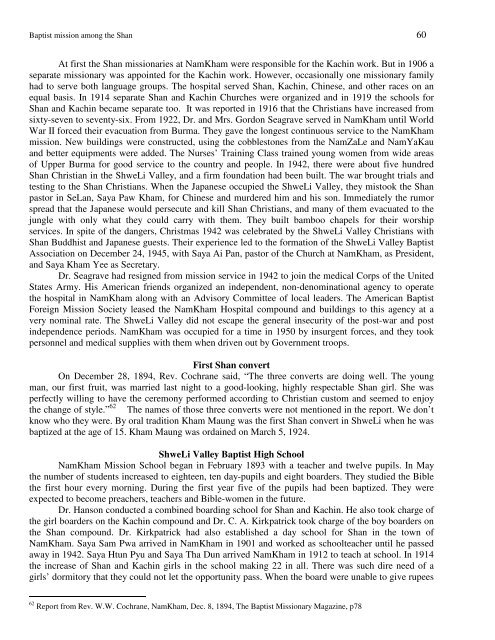History of Shan Churches in Burma 1861-2001 - Khamkoo
History of Shan Churches in Burma 1861-2001 - Khamkoo
History of Shan Churches in Burma 1861-2001 - Khamkoo
You also want an ePaper? Increase the reach of your titles
YUMPU automatically turns print PDFs into web optimized ePapers that Google loves.
Baptist mission among the <strong>Shan</strong> 60<br />
At first the <strong>Shan</strong> missionaries at NamKham were responsible for the Kach<strong>in</strong> work. But <strong>in</strong> 1906 a<br />
separate missionary was appo<strong>in</strong>ted for the Kach<strong>in</strong> work. However, occasionally one missionary family<br />
had to serve both language groups. The hospital served <strong>Shan</strong>, Kach<strong>in</strong>, Ch<strong>in</strong>ese, and other races on an<br />
equal basis. In 1914 separate <strong>Shan</strong> and Kach<strong>in</strong> <strong>Churches</strong> were organized and <strong>in</strong> 1919 the schools for<br />
<strong>Shan</strong> and Kach<strong>in</strong> became separate too. It was reported <strong>in</strong> 1916 that the Christians have <strong>in</strong>creased from<br />
sixty-seven to seventy-six. From 1922, Dr. and Mrs. Gordon Seagrave served <strong>in</strong> NamKham until World<br />
War II forced their evacuation from <strong>Burma</strong>. They gave the longest cont<strong>in</strong>uous service to the NamKham<br />
mission. New build<strong>in</strong>gs were constructed, us<strong>in</strong>g the cobblestones from the NamZaLe and NamYaKau<br />
and better equipments were added. The Nurses’ Tra<strong>in</strong><strong>in</strong>g Class tra<strong>in</strong>ed young women from wide areas<br />
<strong>of</strong> Upper <strong>Burma</strong> for good service to the country and people. In 1942, there were about five hundred<br />
<strong>Shan</strong> Christian <strong>in</strong> the ShweLi Valley, and a firm foundation had been built. The war brought trials and<br />
test<strong>in</strong>g to the <strong>Shan</strong> Christians. When the Japanese occupied the ShweLi Valley, they mistook the <strong>Shan</strong><br />
pastor <strong>in</strong> SeLan, Saya Paw Kham, for Ch<strong>in</strong>ese and murdered him and his son. Immediately the rumor<br />
spread that the Japanese would persecute and kill <strong>Shan</strong> Christians, and many <strong>of</strong> them evacuated to the<br />
jungle with only what they could carry with them. They built bamboo chapels for their worship<br />
services. In spite <strong>of</strong> the dangers, Christmas 1942 was celebrated by the ShweLi Valley Christians with<br />
<strong>Shan</strong> Buddhist and Japanese guests. Their experience led to the formation <strong>of</strong> the ShweLi Valley Baptist<br />
Association on December 24, 1945, with Saya Ai Pan, pastor <strong>of</strong> the Church at NamKham, as President,<br />
and Saya Kham Yee as Secretary.<br />
Dr. Seagrave had resigned from mission service <strong>in</strong> 1942 to jo<strong>in</strong> the medical Corps <strong>of</strong> the United<br />
States Army. His American friends organized an <strong>in</strong>dependent, non-denom<strong>in</strong>ational agency to operate<br />
the hospital <strong>in</strong> NamKham along with an Advisory Committee <strong>of</strong> local leaders. The American Baptist<br />
Foreign Mission Society leased the NamKham Hospital compound and build<strong>in</strong>gs to this agency at a<br />
very nom<strong>in</strong>al rate. The ShweLi Valley did not escape the general <strong>in</strong>security <strong>of</strong> the post-war and post<br />
<strong>in</strong>dependence periods. NamKham was occupied for a time <strong>in</strong> 1950 by <strong>in</strong>surgent forces, and they took<br />
personnel and medical supplies with them when driven out by Government troops.<br />
First <strong>Shan</strong> convert<br />
On December 28, 1894, Rev. Cochrane said, “The three converts are do<strong>in</strong>g well. The young<br />
man, our first fruit, was married last night to a good-look<strong>in</strong>g, highly respectable <strong>Shan</strong> girl. She was<br />
perfectly will<strong>in</strong>g to have the ceremony performed accord<strong>in</strong>g to Christian custom and seemed to enjoy<br />
the change <strong>of</strong> style.” 62 The names <strong>of</strong> those three converts were not mentioned <strong>in</strong> the report. We don’t<br />
know who they were. By oral tradition Kham Maung was the first <strong>Shan</strong> convert <strong>in</strong> ShweLi when he was<br />
baptized at the age <strong>of</strong> 15. Kham Maung was orda<strong>in</strong>ed on March 5, 1924.<br />
ShweLi Valley Baptist High School<br />
NamKham Mission School began <strong>in</strong> February 1893 with a teacher and twelve pupils. In May<br />
the number <strong>of</strong> students <strong>in</strong>creased to eighteen, ten day-pupils and eight boarders. They studied the Bible<br />
the first hour every morn<strong>in</strong>g. Dur<strong>in</strong>g the first year five <strong>of</strong> the pupils had been baptized. They were<br />
expected to become preachers, teachers and Bible-women <strong>in</strong> the future.<br />
Dr. Hanson conducted a comb<strong>in</strong>ed board<strong>in</strong>g school for <strong>Shan</strong> and Kach<strong>in</strong>. He also took charge <strong>of</strong><br />
the girl boarders on the Kach<strong>in</strong> compound and Dr. C. A. Kirkpatrick took charge <strong>of</strong> the boy boarders on<br />
the <strong>Shan</strong> compound. Dr. Kirkpatrick had also established a day school for <strong>Shan</strong> <strong>in</strong> the town <strong>of</strong><br />
NamKham. Saya Sam Pwa arrived <strong>in</strong> NamKham <strong>in</strong> 1901 and worked as schoolteacher until he passed<br />
away <strong>in</strong> 1942. Saya Htun Pyu and Saya Tha Dun arrived NamKham <strong>in</strong> 1912 to teach at school. In 1914<br />
the <strong>in</strong>crease <strong>of</strong> <strong>Shan</strong> and Kach<strong>in</strong> girls <strong>in</strong> the school mak<strong>in</strong>g 22 <strong>in</strong> all. There was such dire need <strong>of</strong> a<br />
girls’ dormitory that they could not let the opportunity pass. When the board were unable to give rupees<br />
62 Report from Rev. W.W. Cochrane, NamKham, Dec. 8, 1894, The Baptist Missionary Magaz<strong>in</strong>e, p78
















